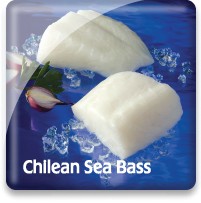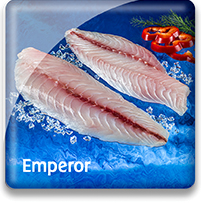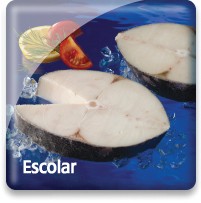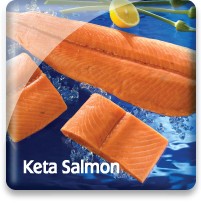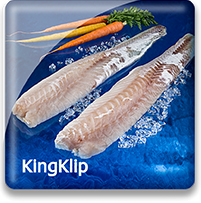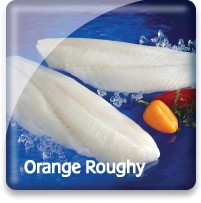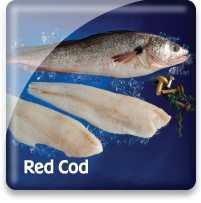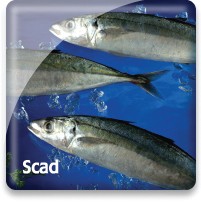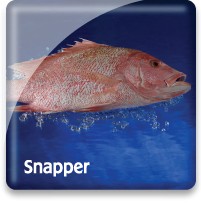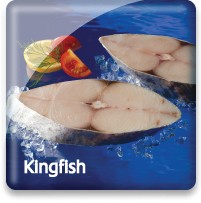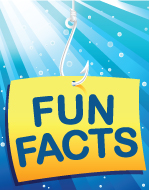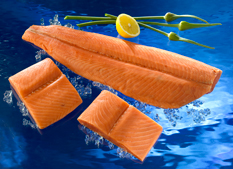
Keta Salmon (Chum)

Market Name: Eating QualitiesWith the lowest oil content and a less full-bodied taste than the other Pacific salmon species, chums enjoy an import niche in the retail/foodservice sector. The mild flavor and firm texture makes it an easy option for casseroles and other dishes involving moisture. With a long freezer life and a less “fishy” taste, Chums are a less expensive choice for salmon connoisseurs.
Chum salmon take their name from the Chinook term meaning “spotted” or “marked,” while pink salmon are named for the color of their flesh.
|
Description & CharacteristicsHokkaido and Alaska K Chum/Keta Salmon, like all other Pacific salmon species, are anadromous. They can live about six years at sea before returning to their freshwater spawning grounds; Keta Salmon spend more time out at sea than any other pacific salmon species. Keta Salmon are caught from June until November or December, with peak supplies in July and August. The low fat content and lighter color of the Keta Salmon are why it’s the less-prized salmon, although for these reasons it has a longer shelf life. Hokkaido and Alaska origin Keta Salmon are known in the market as a great alternative to the higher priced salmon species. Chum salmon are the most widely distributed of all the Pacific salmon species, and they are very abundant in Alaska and in Japan (Hokkaido) which has the world's largest Chum/Keta fishery. There is an old indian legend about Chums that tells how their name came about. The Chehalis Indians, a river-dependent tribe located in the Pacific Northwest, speak of a spirit called Honne who thought very highly of the Chum salmon. Legend has it that Honne named the Chums the chief of the salmon and gave them the name Klahwhi, which means dog salmon. This is why, locally, they are referred to as dogfish today. Chums, like all other Pacific salmon species, are anadromous. They can live about six years at sea before they return to their spawning grounds. They can be found as far south as San Francisco, as far north as the Yukon, and northwest into the Bering Sea and Russia. Some of the most flourishing Chum stocks are in Japan, where extensive work of raising smolts has been done to enhance Chum supplies. Landlocked populations of Chums do not exist. Chums also spend more time out at sea than any other Pacific salmon species. Fresh Chums should be available from June until November or December, with peak supplies in July and August. There are some rivers that have two runs of Chums and in these, the summer run is generally abundant with small fish while the fall run has much larger fish.Unlike some of its salmon cousins that are confused among each other because of spotting and lateral lines, the confusion associated with Chums is with their nomenclature. Chums can be called silverbrites, brites, semibrites, and darks—all terms that refer to the grading of the fish’s meat color, not the fish itself. As the fish moves into fresh water, the skin develops watermarks and the flesh loses some of its color, thus the quality lessens. Chums are one of the most complex salmon species to buy due to their range of names and quality designations. A full description, including where the fish was harvested, is essential when purchasing any seafood species. Chums average between eight and 12 pounds and are one of the most popular frozen salmon items for retail/foodservice. They are also a popular canned item where you may be able to find it marketed as Keta, its Latin species name. Chums are also popular among European smokers.
Headless, dressed Chums are normally graded 2–4 lbs, 4–6 lbs, 6–9 lbs, 9–12 lbs, and 12–up lbs. Chum fillets are graded 1-2, 2-3, 3-4, and 4-5 lbs. Portions are graded 4, 6, 8, 10 and 12 ounces. Canned, smoked items are available as well as many roe and egg products. Their roe is the most prized out of all the salmon species. Other Resources |
Handling Instructions for Keta Salmon (Chum)
Keta (chum) salmon should be stored frozen at or below 0°F (-18°C) and then thawed properly when ready to cook. Our salmon portions and fillets are packed IQF and individually vacuum packed. The frozen shelf life of our keta is 18 months. Links to proper seafood handling instructions: NOAA - Fish Watch: Handling Seafood and A Consumer Guide to Safe Seafood Handling.
Thawing Keta Salmon (Chum)
Keta portions and fillets should be removed from their vacuum packs or poly wraps, placed in a tight fitting plastic bag or covered container and placed under refrigeration between 33 and 39°F until they are completely thawed. This thawing process takes between 12 and 24 hours to be completed
Important Instructions for Keta Salmon (Chum)
Keta salmon should be used immediately or continued to be held under the proper refrigeration and consumed within 2-3 days.
The Federal Food, Drug and Cosmetic Act now requires that all foods that are not raw agricultural commodities and that contain a major food allergen be labeled to clearly identify the name of the food source form which the allergen is derived. (21 CFR U.S.C. 343(w)(1)). The act defines eight foods, and any ingredients derived from these foods as major food allergens: Fish, Crustacean Shellfish, Milk, Eggs, Tree Nuts, Peanuts, Wheat & Soybeans. The name of the food source that must be listed on the label for fish or crustacean shellfish must be the specific type of fish or crustacean shellfish. The market names of species of fish and crustacean shellfish should be used to identify the food source of these two major food allergens. If you intend to re-pack these seafood products, be sure the allergen is declared in either one of two ways:
1) Within the list of ingredients
or
2) In a separate “Contains” statement immediately after or adjacent to the list of ingredients.
Consult the Fish and Fishery Products Hazards and Controls Guidance, Fourth Edition, Chapter 19 for more detailed information on the labeling of food allergens.
Cooking Tips
Keta salmon can be prepared using a wide variety of cooking methods. Link to cooking tips and recipes.
China
With more than 1.3 billion people, China is today the world’s most populous country. With a growing economy fueling an appetite for seafood, China has begun importing seafood for in-country consumption, as well as exporting a great deal of its production. In fact, since 2002, China has continued to export more fish and fishery products than any other country in the world, with Japan, the United States, and the Republic of Korea as its main export markets.
Chinese distant water fishing activities started in 1985 when China gained access to new fishing grounds through agreements with foreign countries. China operates vessels in West Africa, the North Pacific, and tuna longline vessels in the South Pacific. In addition, squid are harvested in the Japan Sea, the South Atlantic, and the North Pacific under Chinese-flagged vessels.
Carp are also commercially important, as are bream, shad, eel, catfish, rainbow trout, salmon, whitebait, mullet, mandarin fish, perch, sturgeon, and murrel (snakehead). Commercial shellfish include Saltwater & freshwater shrimp, river crabs, and mollusks such as mussels, clams, oysters, and freshwater snails.
With one-fifth of the world’s population, and an official government policy to promote aquaculture, China has today become an aquaculture powerhouse, now producing more than two-thirds of the world’s aquaculture species. Fish and shellfish are grown in freshwater and saltwater environments.
Japan
Japan is an island nation that historically has had worldwide access to all the worlds fishing grounds to supply its seafood loving population who have the highest per capita seafood consumption of any developed nation. This access was severely curtailed in 1982 by the worldwide adoption of the UN Convention on the Law of the Sea that established 200 mile marine Exclusive Economic Zones for all nations with coastlines. In spite of this historical development, Japan today ranks fifth in world production of wild fisheries which comprises approximately 65% of their seafood production while aquaculture currently comprises the remaining 35% of their seafood production. Japan’s aquaculture production ranks 10th in the world and produces various shellfish, finfish, and seaweed. Japan consumes approximately 10% of the entire world’s wild caught fisheries which is comprised of a vast variety of finfish, crustaceans, and shellfish. Japan is also consuming an ever growing percentage of the world’s aquaculture production. They import much more seafood than they export, but the seafood they do export is generally considered to be high quality.
The United States
The United States of America has over 95 thousand miles of coastline, ranks fourth in the world in wild capture fisheries and thirteenth in aquaculture production. The wild capture fisheries is dominated by Alaska pollock and followed by menhaden, salmon, flatfish, and cod. After these wild caught finfish species which comprise 84% of the entire wild catch, the remaining capture fisheries primarily consist of crab, shrimp, and shellfish. Aquaculture production in the U.S. is comprised of roughly 70% freshwater and 30% marine farms. Freshwater aquaculture is dominated by catfish and followed by trout production while the marine aquaculture in comprised of 65% shellfish (clams, oysters, & mussels), 25% salmon, and 10% shrimp. At present, aquaculture represents 5% of the total U.S. seafood production. The long term sustainability of U.S. wild fisheries has been the goal of the 1976 Magnuson-Stevens Act. The National Marine Fisheries Service manages all activities to achieve this goal and at this time the majority of wild capture fisheries in the U.S. are sustainable. In 2011 the U.S. Department of Commerce and the National Oceanic and Atmospheric Administration released policies that promote the accelerated development of marine aquaculture. Both wild fisheries and aquaculture in the United States are currently well managed for sustainable growth.
Go Blue! Seafood Sustainability Spectrum*Click here for an explanation of our Sustainability Spectrum .jpg)
Sustainability AssessmentKeta Salmon (also called Chum Salmon) fisheries in Hokkaido, Japan are generally well-managed, with healthy abundances. Hokkaido Keta Salmon fisheries are enhanced with hatchery released fish. MSC is currently not assessing the Hokkaido Keta Salmon fishery for certification. However, the Hokkaido Fishery Cooperative that left the MSC program, is currently considering launching a Fishery Improvement Project (FIP), that would lay out the next steps in improving this globally important fishery. Keta salmon in Hokkaido are primarily caught with net traps. The traps consist of a net lead with up to three traps attached. Salmon migrating along the coast encounter the trap lead and are funneled into one of the traps. This gear interacts with marine mammals, but management measures are in place to ensure they do not negatively impact marine mammal populations. Because Sea Port’s Keta Salmon is processed in China, it is important to maintain traceability, as Keta Salmon originating in other countries may have more serious environmental impacts associated with them. In addition to sourcing Chum Salmon from Japan, Sea Port also sources from the United States Alaska fisheries that are certified sustainable by the ASMI Responsible Fisheries Management program, by MSC, and is given a "Best Choice" rating by Monterey Bay Aquarium's Seafood Watch Program. Wild harvests of Chum Salmon are also used from Canadian fisheries that have likewise been certificed by MSC and recommended by Seafood Watch as sustainabile.
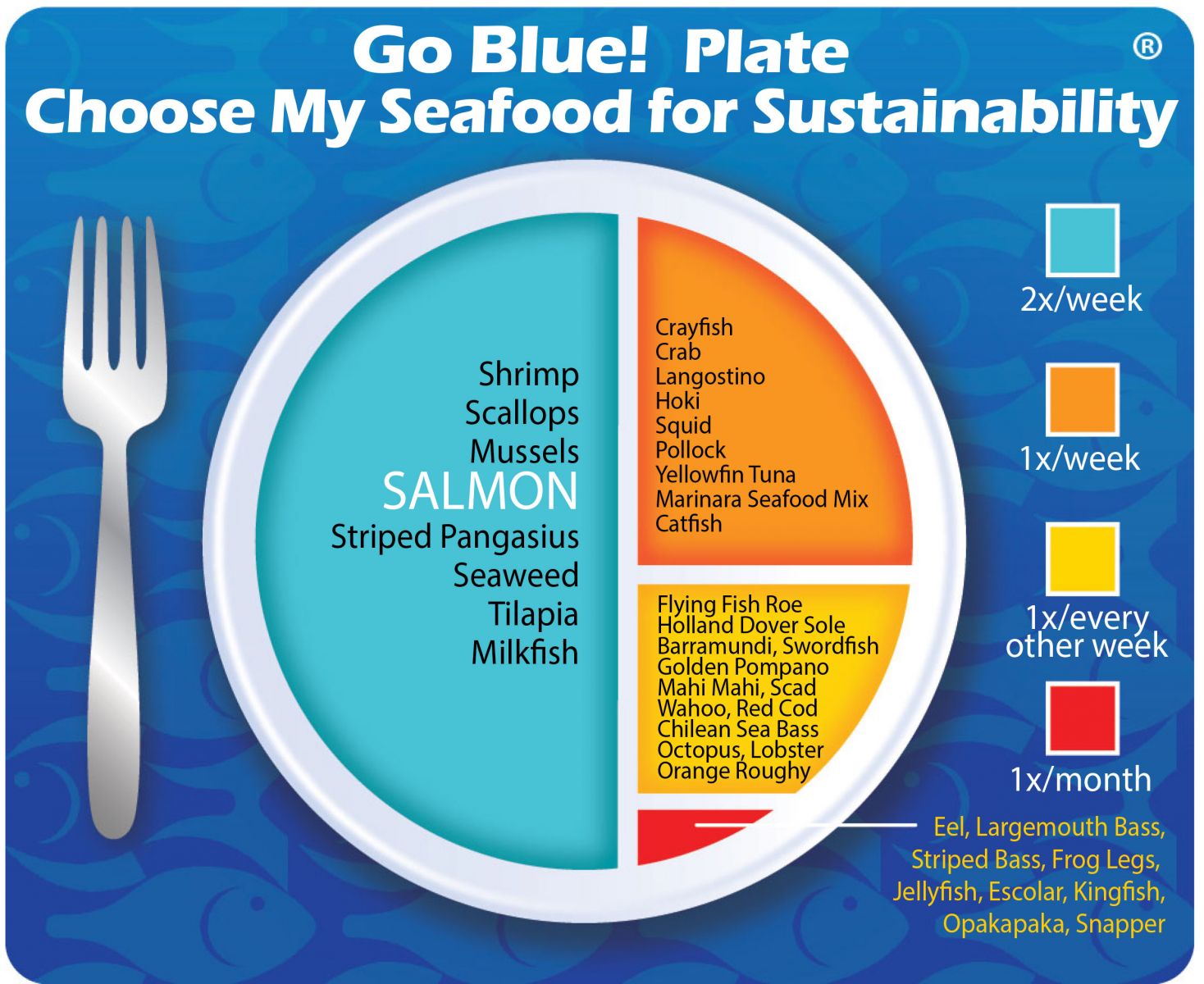
Environmental Impact: Low to Moderately LowStrong management measures are in place in both Japan and in the United States to ensure adequate levels of adult fish escape entrapment and can swim upriver to spawn, and that interactions with marine mammals do not negatively affect marine mammal populations. Because Hokkaido and Alaska Keta Salmon fisheries are enhanced with hatchery released fish, it is uncertain what percentage of the catch is truly wild, and how these hatchery releases may affect wild fish.
Sustainability Improvements NeededImprovements are needed in data collection in Hokkaido to better determine how wild populations are affected by hatchery releases. Currently the United States Alaska Chum fisheries are the best managed of all Pacific stocks.
Actions that Sea Port is UndertakingSea Port is requiring that their suppliers provide fishing vessel identification (when available), catch methodology, and catch area information. In doing so, Sea Port is encouraging improved traceability for all its Keta Salmon processed in China whether sourced from Alaska or Japan. Sea Port believes that, in aggregate, choosing from a diverse variety of seafood is better for sustaining the world’s seafood resources and that Keta Salmon should be a part of this variety. We created the sustainability assessments for each of our seafood items in order to reveal the existing and potential environmental impacts and risks that are associated with producing them for human consumption. This allowed us to establish the starting position for each of our seafood items along our progressive Go Blue! Seafood Sustainability Spectrum®. These assessments are only a single snapshot in time and because of this, we will continue to assess and update the critical sustainability needs associated with our supply sources and issue updates to the Go Blue! Seafood Sustainability Spectrum® as needed. There is a growing global awareness for the need to assure the sustainability of farmed and wild caught seafood and because of this; all around the world positive changes are rapidly occurring at all levels of the seafood supply chain. We will continue to spread this growing awareness and work with our many industry partners to improve the sustainability of all seafood, which we believe is the ideal protein of choice to feed an ever growing world population. Our Go Blue! Seafood Sustainability Spectrum® serves as our compass and yardstick as we strive to move all our products forward to becoming more sustainable. Please join us in this committed quest and Catch Our Wave® to sustainability by choosing a diverse variety of responsibly produced seafood as part of your diet. |


